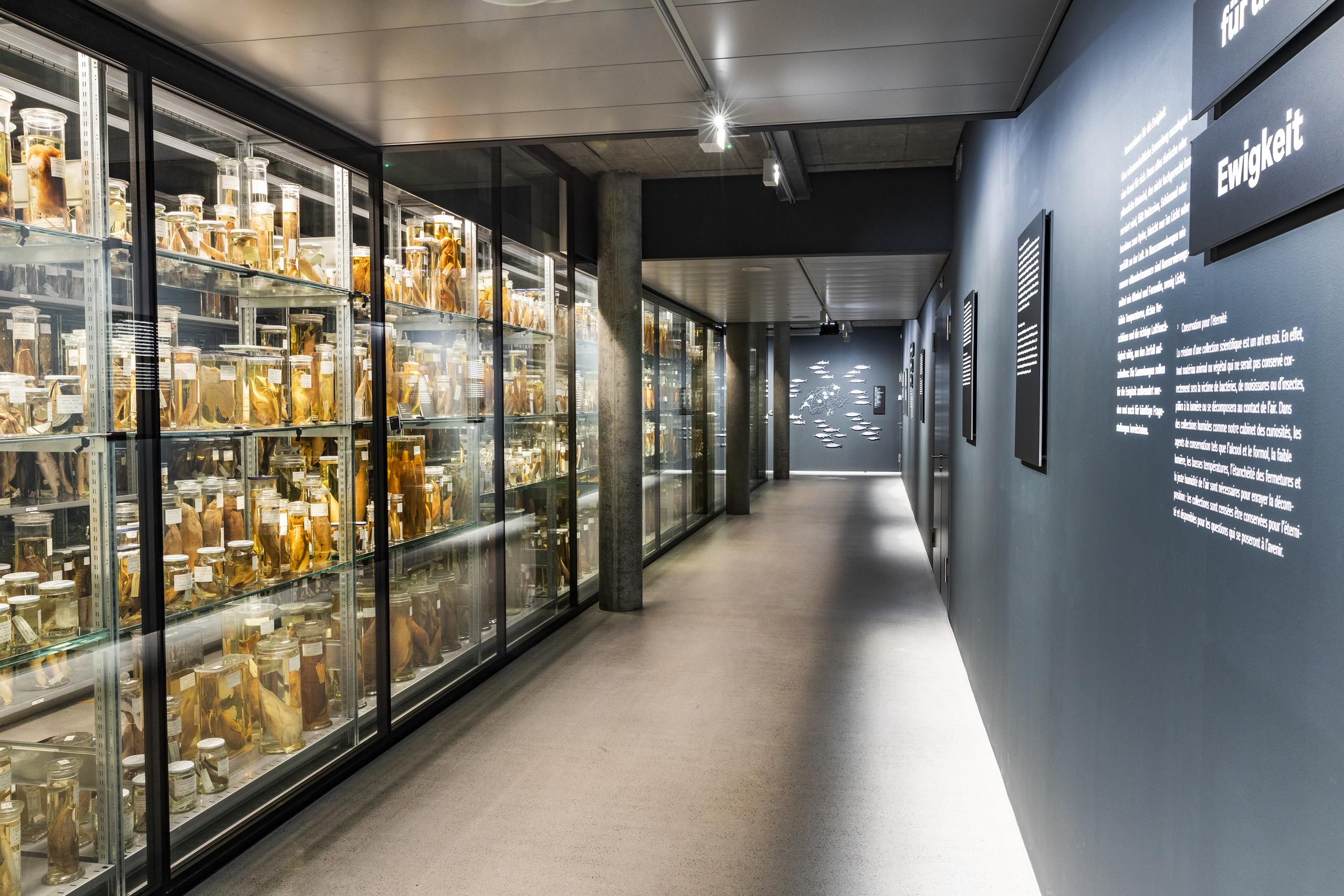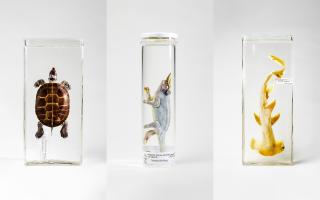It was thanks to the popular special exhibition «T. rex – Do we know each other?» that the year 2020 started as 2019 finished: with record numbers of visitors to the museum. By the end of January 2020, more than 100,000 people had seen the dinosaur display, which travelled on to the Natural History Museum in London in the spring. In February, the new installation «Resurrecting the Sublime» opened. A scent diorama created by Christina Agapakis, Alexandra Daisy Ginsberg and Sissel Tolaas, it allows visitors to smell the aroma of an extinct plant. The installation explores the crossovers between science and art and occupies the last room of the special exhibition «Apocalypse – End Without End». In hindsight, this engagement with the topic of recurring apocalypses seems almost prophetic.
2020 – highlights behind closed doors
Compared to a normal year, in 2020 the Natural History Museum of Bern (NMBE) remained closed for about a third of the time. This was also reflected in the visitor numbers: the museum recorded 97,615 visitors in 2020, of which 7,536 were people attending events. For the first time in 10 years, we did not exceed the 100,000 mark; the last time this happened was in 2010, when 97,306 visitors were recorded. Compared to the record year of 2019 (192,800 visitors), this represents a fall of around 50%. The planned highlights in the events calendar – Museums Night, «Dullins Tiershow», teacher training, Winterberg’s Bestiary, Snail Safari, Pica Club, animal drawing, etc. – were affected by cancellations and postponements. The new permanent exhibition «Cabinet of Curiosities – The display collection», which launched in November, was only open briefly until the end of the year. This presentation of a natural history collection, unique within Switzerland, offers visitors a spectacular insight into the research and collections of the NMBE. With over 19,000 exhibits, the Cabinet of Curiosities makes a part of the collection accessible to the public. Walking around among shelves reaching up to the ceiling, you are visiting not just a scientific collection, but an active research site and a diverse archive of life as well.
Outlook for 2021
On 9 April 2021, the new special exhibition «Queer – Diversity is in our nature» will open. «Queer» stands for sexual and gender diversity and the NMBE offers an insight into the diversity of gender and sexuality to be found in nature and among humans – a diversity that is already part of our society, yet sometimes still leads to controversy. Again and again, we hear the question, ‘What is natural?’ The exhibition forms a bridge between biology and society. The vibrant accompanying events programme features the fabulous «Late Night Drag Show», opportunities for deeper discussion in an intimate fireside setting, and ‘seduction tours’ of the exhibition.
The Bern theme year «The city needs nature - more biodiversity in Bern» has been postponed to 2021. As a partner for this project, the NMBE is providing support, in particular with its expertise in the area of Swiss species diversity.

Our museum is also a research site
Behind closed doors, there was plenty of research taking place at the NMBE in 2020. The scientists worked on regional and international projects, conducted research together with the local population, identified new species and added to the collection.
For many years, the NMBE has been searching for and researching meteorites in Oman. In 2020, a search campaign was carried out in cooperation with the Ministry of Heritage and Tourism of the Sultanate of Oman for the first time. In addition, meteorites that have been fully examined started to be returned to Oman from the NMBE in 2020.
Another collaborative project, this time with the residents of Bern, was launched by the NMBE – the «red wood ant» project. This «citizen science» project looks at the distribution of native red wood ants in the canton of Bern. Approximately 3,000 new nests of these important insects – sometimes described as the ‘health police of the forest’ – were mapped in 2020. A previously established ‘citizen science’ project studying the Twannberg meteorite also continued: 280 findings expanded the known strewn field.
There were also impressive findings as a result of site visits to the Jura Cement quarry: the newly discovered echinoderm fossils are presented in their own display case in the extended special exhibition «Five stars – sensational fossil finds from the Jura Mountains». Three new snail species were also discovered and newly documented, as well as three parasitic wasp species, which deposit their own eggs within those of the praying mantis. Scientists at the NMBE were also involved in an international research project focusing on the Indian ‘Gollum snakehead fish’. The project team was able to show that this is not just one new species, but in fact a new, distinct family.
Biodiversity is a key research area for the NMBE and in 2020 our broad focus was brought to the fore in projects involving molluscs. The museum participated in a global study showing the precarious situation of freshwater mussels and snails: several hundred species are already extinct and 30% of the remaining species are threatened. On the other hand, there are better prospects for the molluscs in the city of Bern: a surprising number of mollusc species can be found in the city’s Botanical Gardens, as an inventory project by the museum demonstrated.
This year once again saw the publication of numerous articles and several books. One of these is a newly revised edition of the classic «Vögel beobachten in der Schweiz» (Birdwatching in Switzerland). This bird guide, suitable both for seasoned birdwatchers and novices, describes the best locations for exciting sightings and helps uncover the wonderful world of our native birds. The 38th volume of the NMBE’s journal Contributions to Natural History took the form of a 500-page monograph on fairy longhorn moths. This bestseller, already sold out, was a result of a cooperation with the Bern Entomological Society.
The Swiss National Science Foundation has approved a new project to continue our meteorite research in Oman. As part of the project starting in 2021, camera stations will be set up in Oman to observe new meteorite falls.





